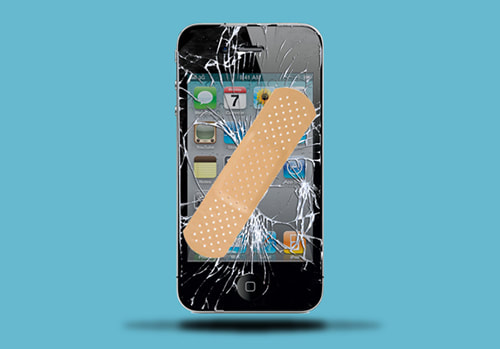That experience reminds me of the many products we use each day but seldom repair when they break. For instance, most of us don’t think of fixing a broken toaster; we look for a new one. This tendency to replace instead of repair places significant strain on our environment, but the practice becomes even more troubling when talking about expensive and easily ‘injured’ items like our ever-present smartphones.
If you own a smartphone and haven’t dropped it or had some other mishap, you’re either extremely careful or very lucky because, “Each year millions of cell phone owner’s drop, sit on, flush, swim with and even throw their phone, which normally results in some sort of damage.” After such an unfortunate occurrence, the question becomes whether to repair or replace the indispensable device, which probably cost at least a couple of hundred dollars, or several hundred-plus if you’re packing a newer iPhone or the latest Samsung Galaxy.
Fortunately, a variety of online outlets will repair broken phones, for example:
However, using an online organization for repairs requires a major sacrifice of time. Many people can’t be without their smartphone for a few hours, let alone several days or more. And, there’s the issue of trust: We don’t know these companies well and can’t watch them make the repair. How can we be sure they’re respecting our privacy when so much of our lives literally rests in their hands?
Also, again, there’s the issue of cost. Is it worth $100 or more to repair even a relatively new device when technology is changing so quickly? As a result, it’s easy to rationalize spending a few hundred more to have a new one.
You may be wondering, "Where are the smartphone manufacturers? Why don’t the cellphone companies have our backs when their products so easily and often get broken?" In the U.S., that criticism has hit especially hard at Apple, which has a whopping 44.6% share of the smartphone market.
For years, the only place iPhone users could get their cracked screens ‘officially’ replaced was at an Apple store. Unauthorized repair centers, like the three listed above, might be able to fix the phones, but if Apple later detected their work on the device, the warranty would be voided.
Apple would suggest that the reason it has kept a tight rein on screen repairs is that it wants them done right, especially “to ensure that the new screen is properly calibrated – and in particular to allow the Touch ID sensor to be replaced without bricking the phone or losing use of the sensor.” Those more cynical about the tech leader’s motives might suggest that Apple wants to drive business to its own stores in order to capture the repair revenue or, even better, to sell users new iPhones and other items, i.e, to replace, not repair.
In any case, there are currently about 270 Apple stores in the U.S. That number may seem high, but it’s not when you consider, for instance, that Illinois and Pennsylvania, the fifth and sixth most populous states in the nation have 12.8 million and 12.7 million residents, respectively, but only nine Apple stores each. Such ratios can mean a loooong time waiting at a Genius Bar.
The good news is that Apple has recently eased its repair site exclusivity. The firm has finally authorized a few select retailers to fix broken iPhone screens. How can Apple guarantee the quality of those third-party repairs? Well, the company has not conceded control completely.
Apple is giving each authorized repair center a highly-specialized and proprietary machine that not only replaces the screens but also tells “the iPhone’s processor, its silicon brain, to recognize a replacement sensor. Without it, the iPhone won’t unlock with the touch of a finger. Banking apps that require a fingerprint won’t work either, including the Apple Pay digital wallet.” Pictures of the closely guarded apparatus can be found on 9 to 5 Mac website.
Currently only a couple of Best Buy stores in California and Florida have these machines that are capable of making same-day screen repairs. However, by the end of this year it’s expected that the equipment will be present in “about 400 authorized third-party repair centers in 25 countries.”
So, the future is looking brighter for all of us clumsy iPhone users, but won’t the delegation of this service take a bite out of Apple’s business? What about its revenue from repairs, the loss of traffic in Apple stores, and the sale of new iPhones? All of the above are real considerations but they pale in comparison to one meta-goal for Apple: maintaining its strong brand.
Apple has become the most valuable brand in the world for a variety of reasons, but the overarching one is strong customer satisfaction. People who use Apple products are almost always delighted because of their look, their performance, and the aura around them. Apple smartly wants to avoid tainting that stellar reputation, which could occur if people become disenfranchised from inconvenient and lengthy repairs.
However, averting a negative product experience is probably only part of Apple’s plan. The company also needs to increasingly position itself as a good steward of resources and as an organization that cares about the natural environment. Allowing smartphones that still have significant useful life to prematurely become paper weights or other waste does not accomplish those objectives.
Likewise, as the market for smartphones becomes more and more saturated and competitors’ product features converge, factors like repair service and social responsibility will likely gain weight as decision-making criteria. Every point of difference matters in a mature market.
Apple’s decision to outsource and broaden its repair network will be very helpful for consumers. The strategy also will prove very beneficial for the firm. As it’s done many times before, Apple has made an adept move that can be called “Mindful Marketing.”
Learn more about the Mindful Matrix and Mindful Meter.
Check out Mindful Marketing Ads and Vote your Mind!




 RSS Feed
RSS Feed